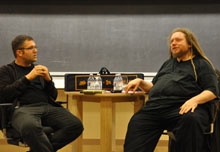
October 4, 2010 — Jaron Lanier, partner architect at Microsoft Research and innovator in residence at the Annenberg School of the University of Southern California, led a Shorenstein Center discussion about “Seeing Through the Fog of Digital Fads.”
Lanier, author of You Are Not a Gadget … A Manifesto, explained that what is needed in the online world is a “middle class,” a class of users that is informed, not manipulated by advertisers and search engines who are funded by advertisers. If information and commerce were affordable rather than free, Lanier speculated, it would be more plentiful, credible and authentic.
There is a bargain between the “heart and head versus the hand and back” that technologists have interfered with, Lanier explained. With a “fascination with meta-human crowd sourcing,” and the idea that “popularity equals achievement,” technology no longer places high value on creative property, Lanier said. He fears that if creative jobs are given away, “everyone becomes a peasant.”
Advertising, Lanier pointed out, has created a “new power struggle on all levels,” with a “hidden power source” that controls and manipulates users and products, and is “corruptible by unseen forces.” There is a need for “universal commerce” without restrictions imposed by “privileged computers” with “superior information.” If people owned their digital property and could make income from selling their property online, they would find it “reasonable to spend money on others’ products.” “Ambiguous hierarchies are better for society,” Lanier said.
Looking forward, Lanier said that “believing the future will be better than the past is essential to healthy technological progression.” He does not see advertising as a sustainable model, and suggested that Google should expand and find ways to create revenue outside of funding from advertisers. “I would pay a penny per search to not be spied on, but that’s not an option,” he said.
This article was written by Janell Sims and the photos taken by Heather McKinnon, both of the Shorenstein Center.

